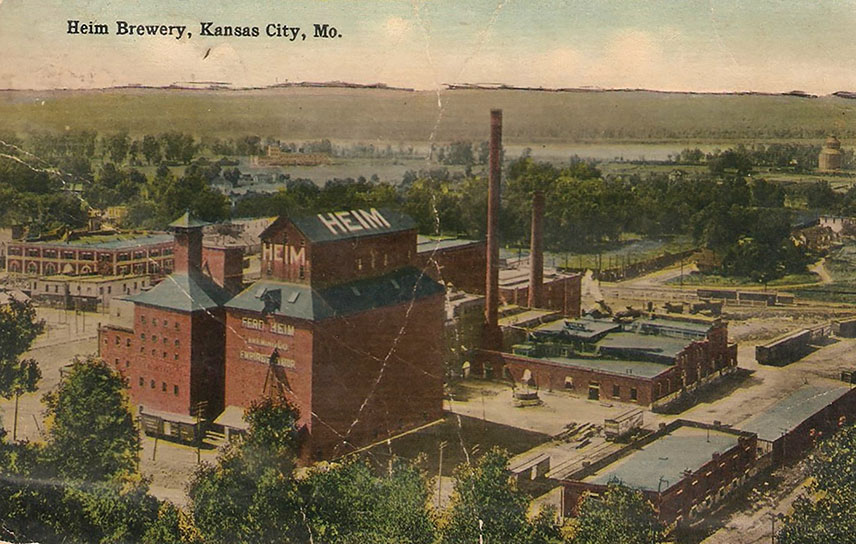Michael Bushnell
Northeast News
Ferdinand Heim, along with his brothers Michael and Joseph, purchased the Star Ale Brewery at 14th and Main Street in 1884 and promptly began to change the brewing landscape in Kansas City. In 1886 the brothers purchased an old sugar refining plant in the city’s East Bottoms area and moved the brewing operation there shortly thereafter. As a way for the brothers to increase the Heim brand in Kansas City, the brothers built a large amusement park at the foot of Chestnut Trafficway, adjacent to the Brewery ,on Rochester in 1899. Electric Park was named for the over 100,000 light bulbs used to highlight the park’s attractions. Interestingly, the park was created as a way for the Heims to offset their cost in constructing a spur streetcar line from the public square downtown to their brewery in the Bottoms. The plan worked, and ridership on the streetcar line was enough to not only offset the line’s construction cost of $96,000, but afforded the brothers the opportunity to sell the line at a healthy profit. Electric Park featured a vaudeville theater, one of the country’s first roller coasters, and of course, a beer garden with fresh beer piped directly under the street from the brewery next door. The brass band of John Phillips Sousa played at the opening of the park and was engaged to play there on a regular basis by the brothers. At dusk, women in gossamer costumes would seem to rise from one of the pools of water in the park much like water nymphs.
The Heims enjoyed great success in the brewing business and at one point in time owned three breweries in Kansas City; the Rochester, the Imperial off Southwest Boulevard near Armourdale and the flagship Heim Brewery. As was the case with beer barons of the day, they also owned scores of taverns and saloons on street corners that only sold Heim beer. Around 1893, the Heim brothers built stately homes on the bluffs that overlooked their brewing empire in the bottoms. Fashionable Benton Boulevard just south of Concourse Park would be the location of the Heim Brother’s mansions. Michael and Ferd Jr. built twin mansions at 328 and 324 Benton Boulevard, respectively. The impressive brick manses were separated by a huge carriage house in the rear of the lot, and a heart shaped circular drive with a beautiful fountain in the center. Ferdinand Sr. built a home just north of Ferd Jr at 318 Benton Boulevard and Joseph Heim built a stately home overlooking the park at 300 Benton Boulevard. All four of the Heim homes still stand today.
The Heim’s business interests were as wide and varied as the brothers themselves. They owned a piece of a professional baseball team, held interests in both the Home and Bell telephone companies and were widely invested in natural gas distributorships in the Midwest. A family of firsts, the brothers had the first private telephone exchange in the city. Additionally, the brothers owned the first 25 horsepower engine in town and had the first top loading ice box. Ferd Heim Sr. was the first Kansas City resident to drive an automobile with a back seat. Ferd Jr. also has the distinction of being the first $1,000 donor to the newly formed Kansas City Museum in 1940.
As the city’s population began to move south, the brothers scouted land outside the then city limits near 47th street and The Paseo. In 1907 the second Electric Park opened to great fanfare. Over 100,000 electric lightbulbs lit the Brush Creek valley as the new park was christened on May 19th, 1907. In 1917, President Theodore Roosevelt spoke at the park to a crowd of over 40,000 people.
A series of fires over the years, as well as a changing taste in recreation, began to spell doom for the park. During the 1920s a fire destroyed the dance pavilion and part of the beer garden. A second fire in 1934 closed the park for good. In 1948 what remained of the park’s coaster was torn down to make way for the Village Green apartments that stand on the site today.
Prohibition took its toll on the Heims’ business interests and the brewery. Without the income of the brewery the brothers’ savings began to wane. When Joseph Heim died in 1927, it was said at the time of his death he was down to his last million. Michael was the next brother to pass away, dying in Florida at the age of 68. At the time of his death, his estate had dwindled to roughly a quarter-million dollars. In February of 1943, Ferd Heim Jr. succumbed to pneumonia in St. Mary’s Hospital. With his passing, a legacy of Kansas City business interests and a brewing legend faded into history.




















